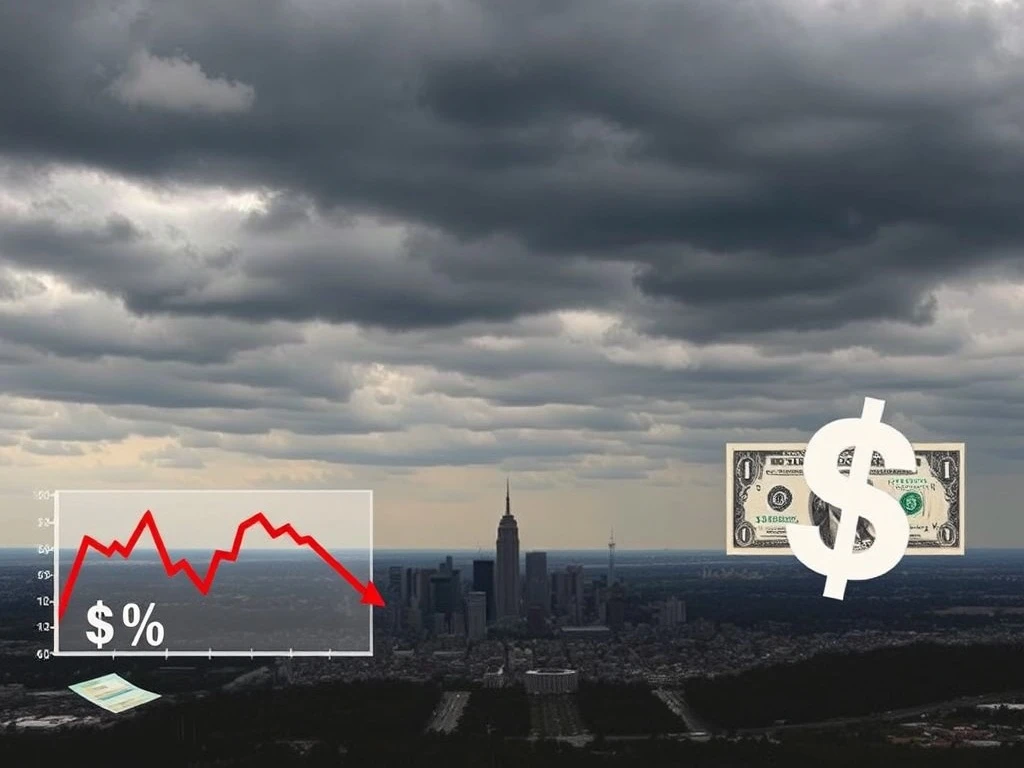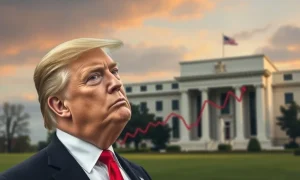A prominent economist recently issued a stark warning: Stagflation US is on the horizon. This forecast carries significant implications for American financial markets. Investors and consumers alike must understand what this economic phenomenon means. It affects the dollar, bonds, and stocks. This article explores the concept of stagflation. It also details its potential impact across key asset classes. Understanding these dynamics is crucial for prudent financial planning.
Understanding the Looming Stagflation US Threat
Firstly, understanding stagflation is crucial. This term describes a challenging economic condition. It combines stagnant economic growth with high inflation. Additionally, high unemployment often accompanies these factors. The 1970s saw a period of severe stagflation globally. This historical precedent offers valuable lessons. During that time, energy shocks contributed significantly. Today, different factors might drive similar outcomes. Economists are closely monitoring various indicators. They aim to identify early warning signs. The potential for Stagflation US raises significant concerns for policymakers and investors.
Why the Concern About Stagflation US Now?
Several current economic indicators fuel concerns about stagflation US. Inflation has remained stubbornly high. Supply chain disruptions persist. Geopolitical tensions also contribute to price pressures. Meanwhile, economic growth shows signs of slowing. Consumer spending, while robust in some areas, faces headwinds. Business investment also shows caution. These combined elements paint a worrying picture. Experts are closely monitoring these trends. Furthermore, central bank actions complicate the outlook. Raising interest rates to combat inflation can slow growth. This delicate balancing act creates uncertainty. Therefore, the risk of a stagflationary environment increases.
The Dollar’s Fate Amidst Stagflation US
The U.S. dollar typically reacts negatively to stagflation. High inflation erodes purchasing power. This reduces the dollar’s value over time. Furthermore, stagnant growth makes the economy less attractive. International investors may seek opportunities elsewhere. This can lead to capital outflows. Consequently, the dollar weakens against other major currencies. A weaker dollar impacts import costs. It also affects the competitiveness of U.S. exports. Imported goods become more expensive. This can further fuel domestic inflation. Conversely, U.S. exports become cheaper for foreign buyers. However, overall economic weakness often overshadows this benefit. Therefore, a weaker dollar presents a complex challenge during stagflation.
How Bonds Respond to Stagflationary Pressures
Bonds usually suffer during periods of stagflation. Inflation erodes the fixed returns of bonds. Investors demand higher yields to compensate. Therefore, existing bonds with lower yields become less attractive. Their prices fall in the secondary market. Central banks face a difficult dilemma. They must balance fighting inflation with supporting growth. Raising interest rates too aggressively could stifle growth further. This makes the bond market particularly volatile. Longer-duration bonds are especially vulnerable. Their value is more sensitive to interest rate changes. Investors often seek shorter-duration instruments. These offer less exposure to fluctuating interest rates. Ultimately, bondholders face real challenges in preserving capital. The erosion of purchasing power is a primary concern.
Stock Market Performance Under Stagflation US
Stocks face a double whammy during stagflation. Stagnant growth hurts corporate revenues. High inflation increases production costs. This squeezes profit margins for businesses. Consumer demand may also weaken. Companies struggle to pass on higher costs. Earnings forecasts often decline. Furthermore, higher interest rates make borrowing more expensive. This impacts business expansion plans. Consequently, stock valuations can fall significantly. Certain sectors, however, might prove more resilient. These include companies with strong pricing power. Utilities and consumer staples often fare better. Their demand remains relatively inelastic. However, the broader market typically experiences declines. Investors become more risk-averse. They shift towards safer assets. Therefore, a stagflationary environment poses considerable risks for equity portfolios.
Strategies for Investors Amidst Stagflation US
Navigating stagflation US requires careful planning. Investors should consider defensive assets. Commodities, like gold, often perform well during inflation. Real estate can also offer some protection. Diversification remains a key strategy. Spreading investments across different asset classes reduces risk. Focus on companies with strong pricing power. These firms can more easily pass on increased costs. Additionally, consider short-duration bonds. These are less sensitive to interest rate changes. Consulting a financial advisor is always prudent. They can help tailor strategies to individual circumstances. Some investors also explore inflation-protected securities. These aim to preserve capital during periods of rising prices. Prudent asset allocation becomes paramount.
Expert Perspectives on the Stagflation Threat
The economist’s warning about stagflation US reflects growing concern. Many analysts share similar views. They point to persistent supply shocks. Energy prices remain a significant factor. Labor market dynamics also play a role. Wage growth, while beneficial for workers, can fuel inflation. The Federal Reserve faces an unprecedented challenge. Its tools are designed for either inflation or recession. Stagflation presents both simultaneously. Therefore, policy responses become complex and difficult. Experts debate the exact likelihood. However, the potential impact warrants serious attention. Understanding these expert insights helps investors. It provides a clearer picture of the risks involved. Furthermore, it highlights the challenges facing economic policymakers.
Government and Central Bank Responses to Stagflation
Addressing stagflation demands coordinated policy. Central banks typically raise interest rates to combat inflation. However, this risks slowing economic growth further. Governments might implement fiscal measures. These could include targeted spending or tax relief. Yet, large fiscal deficits can also contribute to inflation. Policymakers must tread carefully. Their decisions will profoundly impact the economy. The goal is to restore price stability. Simultaneously, they aim to avoid a deep recession. The challenge lies in the trade-offs. Policies designed to fight inflation often hinder growth. Conversely, growth-stimulating policies can exacerbate inflation. This complex dilemma requires innovative solutions. International cooperation may also become necessary. The global nature of some economic pressures necessitates a coordinated approach.
Looking Ahead: Monitoring Key Indicators for Stagflation US
Investors must monitor key economic indicators closely. Inflation rates are paramount. Watch the Consumer Price Index (CPI) and Producer Price Index (PPI). GDP growth figures provide insights into economic health. Unemployment data also offers crucial signals. Global supply chain health is another vital factor. Geopolitical developments also bear watching. These indicators will signal whether stagflation US intensifies. They will also show potential paths to recovery. Pay attention to central bank communications. Their guidance on monetary policy is critical. Government fiscal policy announcements are also important. Staying informed helps investors adapt. It allows them to make timely adjustments. Therefore, continuous vigilance is essential. The economic landscape remains dynamic.
Navigating the Economic Crossroads
The possibility of stagflation US represents a serious economic challenge. Its potential impact on the dollar, bonds, and stocks is significant. While not a certainty, the warning from economists highlights real risks. Understanding these dynamics empowers investors. It allows them to make informed decisions. Careful portfolio adjustments may become necessary. Staying informed remains the best defense. The coming months will reveal much about the economic trajectory. Preparing for various scenarios is a wise approach. Investors should review their financial plans regularly. Professional advice can provide valuable guidance. The goal is to mitigate risks and identify opportunities. Therefore, proactive measures are key.
Frequently Asked Questions (FAQs)
What is stagflation?
Stagflation is an economic condition characterized by slow economic growth, high unemployment, and rising prices (inflation). It presents a unique challenge because typical remedies for inflation (raising interest rates) can worsen economic stagnation, and remedies for stagnation (stimulating growth) can worsen inflation.
How does stagflation affect the U.S. dollar?
During stagflation, high inflation erodes the dollar’s purchasing power, leading to a depreciation in its value. Stagnant economic growth also makes the U.S. economy less attractive to foreign investors, potentially leading to capital outflows and further weakening the dollar against other major currencies.
What happens to bonds during stagflation?
Bonds generally perform poorly during stagflation. The fixed returns of bonds are eroded by high inflation, meaning their real value decreases. To compensate for inflation, investors demand higher yields, which causes the prices of existing bonds with lower yields to fall. Long-duration bonds are particularly vulnerable.
How does stagflation impact the stock market?
Stagflation negatively impacts stocks in several ways. Stagnant growth reduces corporate revenues, while high inflation increases production costs, squeezing profit margins. Higher interest rates also make borrowing more expensive for businesses, hindering expansion. These factors often lead to declining corporate earnings and lower stock valuations.
What strategies can investors use during stagflation?
Investors can consider defensive assets like commodities (e.g., gold) and real estate, which tend to perform better during inflationary periods. Diversification across various asset classes is crucial. Focusing on companies with strong pricing power and considering short-duration bonds can also help mitigate risks. Consulting a financial advisor is recommended.
Has the U.S. experienced stagflation before?
Yes, the U.S. experienced a significant period of stagflation in the 1970s. This era was marked by high oil prices, increased government spending, and a series of economic shocks that led to a combination of high inflation and slow economic growth.
























